For 1962, talented designer Brooks Stevens has done wonders to update all of Studebaker’s models with an extremely limited budget. Larks now sport a large, Mercedes-Benz-like grille (not a coincidence as the German cars are distributed in the U.S. through Studebaker’s network) and standard quad headlights. New round taillights are fitted to the car’s extended rear wings. All four-door cars enjoy the long wheelbase that was reserved until now to the station wagons and the Cruiser sedan. A sporty Daytona is also added to the range.
The Studebaker Lark is under the spotlights in May 1962: the organizers of the Indianapolis 500 have selected the new Avanti to pace their race, but Studebaker being unable to provide the recently-introduced car for the event, it finally substitutes a Lark convertible for it.
Alas, a disastrous strike lasting thirty-eight days early in 1962 somewhat hinders Studebaker’s efforts, limiting the success of the updated range by making the company lose thousands of sales.
Studebaker Lark DeLuxe
The DeLuxe remains the cheapest Lark model. Now without their two-door version, station wagons receive the new front end, but their rearmost part is unchanged. The powerful 4.7-litre V-8 is optional throughout the range this year.
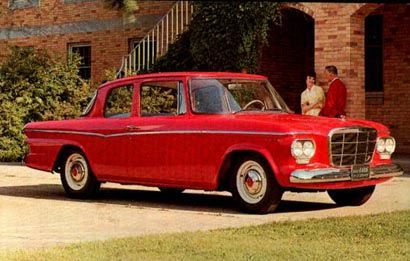
● Introduction: 1952 as the original full-size model, fall 1958 as a shortened and heavily reworked compact. Construction: body on separate chassis. Engine: water-cooled inline six, 2.8-litre, 112 hp, mounted at the front. Optional engines: V-8, 4.2-litre, 180 hp; V-8, 4.2-litre, 195 hp; V-8, 4.7-litre, 210 hp; and V-8, 4.7-litre, 225 hp. Lower compression ratios (and hence lower outputs) could be ordered for exported cars in order to cope with gasoline with poorer octane rates. Transmission: to the rear wheels through a three-speed manual gearbox. Three-speed automatic gearbox optional. Suspension: independent at the front, rigid axle at the rear. Brakes: hydraulic, to drums on all four wheels. Servo optional. Length: 467 cm (two-door models), 475 cm (station wagon), 478 cm (four-door sedan). Top speed: n/a. Range: two-door sedan, four-door sedan, four-door station wagon.
Studebaker Lark Regal
The Lark Regal is a better-appointed version of the DeLuxe that can be distinguished from the cheaper variant by its stainless steel mouldings around the windows and windshield.
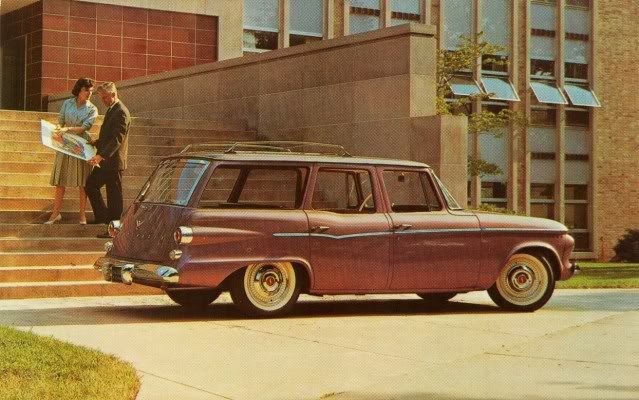
● Introduction: 1952 as the original full-size model, fall 1958 as a shortened and heavily reworked compact. Construction: body on separate chassis. Engine: water-cooled inline six, 2.8-litre, 112 hp, mounted at the front. Optional engines: V-8, 4.2-litre, 180 hp; V-8, 4.2-litre, 195 hp; V-8, 4.7-litre, 210 hp; and V-8, 4.7-litre, 225 hp. Lower compression ratios (and hence lower outputs) could be ordered for exported cars in order to cope with gasoline with poorer octane rates. Transmission: to the rear wheels through a three-speed manual gearbox. Three-speed automatic gearbox optional. Suspension: independent at the front, rigid axle at the rear. Brakes: hydraulic, to drums on all four wheels. Servo optional. Length: 467 cm (two-door models), 475 cm (station wagon), 478 cm (four-door sedan). Top speed: n/a. Range: four-door sedan, two-door hardtop coupe, two-door convertible coupe, four-door station wagon.
Studebaker Lark Daytona
Though the base Daytona does not differ much from lesser Larks apart from a specific side decoration, its option list includes such exclusive items as a Borg-Warner four-speed manual gearbox with floor shifter - the same transmission is available with the Hawk… and the Chevrolet Corvette.
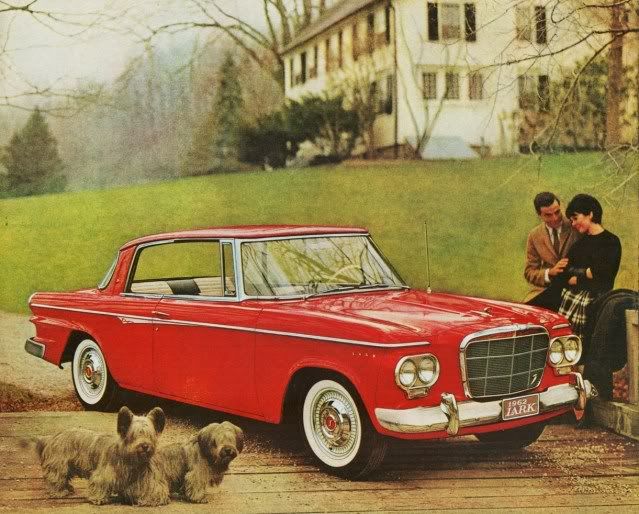
● Introduction: 1952 as the original full-size model, fall 1958 as a shortened and heavily reworked compact, 1961 for the Lark Daytona. Construction: body on separate chassis. Engine: water-cooled inline six, 2.8-litre, 112 hp, mounted at the front. Optional engines: V-8, 4.2-litre, 180 hp; V-8, 4.2-litre, 195 hp; V-8, 4.7-litre, 210 hp; and V-8, 4.7-litre, 225 hp. Lower compression ratios (and hence lower outputs) could be ordered for exported cars in order to cope with gasoline with poorer octane rates. Transmission: to the rear wheels through a three-speed manual gearbox. Four-speed manual and three-speed automatic gearboxes optional. Suspension: independent at the front, rigid axle at the rear. Brakes: hydraulic, to drums on all four wheels. Servo optional. Length: 467 cm. Top speed: n/a. Range: two-door hardtop coupe, two-door convertible coupe.
Studebaker Lark Cruiser
The Lark Cruiser is a luxurious version of the Regal, which loses the advantage of a longer wheelbase this year, but still enjoys a fine upholstery and a standard V-8 engine.
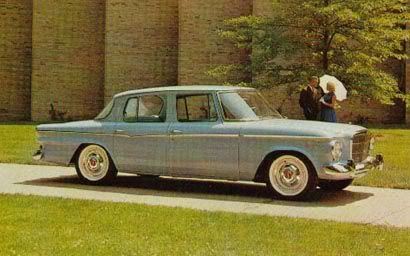
● Introduction: 1952 as the original full-size model, fall 1958 as the shortened and heavily reworked compact, 1960 for the Lark Cruiser. Construction: body on separate chassis. Engine: water-cooled V-8, 4.2-litre, 180 hp, mounted at the front. Optional engines: V-8, 4.2-litre, 195 hp; V-8, 4.7-litre, 210 hp; and V-8, 4.7-litre, 225 hp. Lower compression ratios (and hence lower outputs) could be ordered for exported cars in order to cope with gasoline with poorer octane rates. Transmission: to the rear wheels through a three-speed manual gearbox. Four-speed manual and three-speed automatic gearboxes optional. Suspension: independent at the front, rigid axle at the rear. Brakes: hydraulic, to drums on all four wheels. Servo optional. Length: 478 cm. Top speed: n/a. Range: four-door sedan. Note: a Lark VI Cruiser fitted with the inline six, 2.8-litre, 112 hp engine is available on export markets.
Studebaker Lark Heavy-Duty
Intended for fleets, the heavy-duty version of the Lark is available in three variants this year. An optional “Rural Route” package can adapt these vehicles to mail duties, by adding special warning lights and switching the steering wheel to the right side of the dashboard.
● Introduction: 1952 as the original full-size model, fall 1958 as the shortened and heavily reworked compact. Construction: body on separate chassis. Engine: water-cooled inline six, 2.8-litre, 112 hp, mounted at the front. Optional engines: V-8, 4.2-litre, 180 hp; V-8, 4.2-litre, 195 hp; V-8, 4.7-litre, 210 hp; and V-8, 4.7-litre, 225 hp. Lower compression ratios (and hence lower outputs) could be ordered for exported cars in order to cope with gasoline with poorer octane rates. Transmission: to the rear wheels through a three-speed manual gearbox. Three-speed automatic gearbox optional. Suspension: independent at the front, rigid axle at the rear. Brakes: hydraulic, to drums on all four wheels. Servo optional. Length: 455 cm. Top speed: n/a. Range: two-door sedan, four-door sedan, four-door station wagon.
Studebaker Lark Taxi
This year, a specific heavy-duty vehicle for taxicab use is produced by Studebaker.
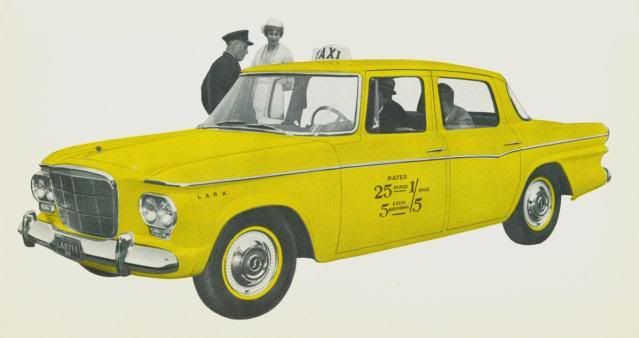
● Introduction: 1952 as the original full-size model, fall 1958 as the shortened and heavily reworked compact. Construction: body on separate chassis. Engine: water-cooled inline six, 2.8-litre, 112 hp, mounted at the front. Optional engines: V-8, 4.2-litre, 180 hp; V-8, 4.2-litre, 195 hp; V-8, 4.7-litre, 210 hp; and V-8, 4.7-litre, 225 hp. Transmission: to the rear wheels through a three-speed manual gearbox. Suspension: independent at the front, rigid axle at the rear. Brakes: hydraulic, to drums on all four wheels. Servo optional. Length: 455 cm. Top speed: n/a. Range: four-door sedan.
Studebaker Lark Marshal
Caring for fleet operators, Studebaker also proposes a Lark designed for law agencies, in a variety of bodies. Various names are applied to these vehicles depending on their engines: “City Marshal” with the 2.8-litre six, “Patrol Marshal” with the 4.2-litre V-8, and “Pursuit Marshal” when fitted with the powerful 4.7-litre V-8.
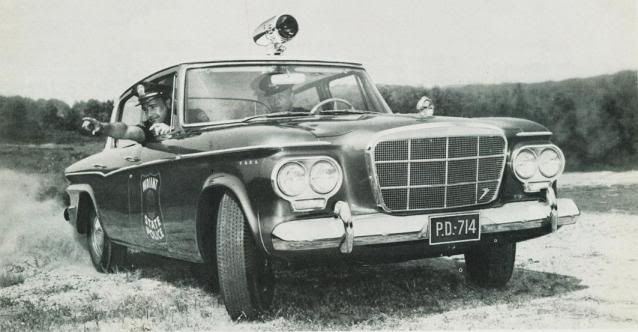
● Introduction: 1952 as the original full-size model, fall 1958 as the shortened and heavily reworked compact. Construction: body on separate chassis. Engine: water-cooled inline six, 2.8-litre, 112 hp, mounted at the front. Optional engines: V-8, 4.2-litre, 180 hp; V-8, 4.2-litre, 195 hp; V-8, 4.7-litre, 210 hp; and V-8, 4.7-litre, 225 hp. Transmission: to the rear wheels through a three-speed manual gearbox. Suspension: independent at the front, rigid axle at the rear. Brakes: hydraulic, to drums on all four wheels. Servo optional. Length: 455 cm. Top speed: n/a. Range: two-door sedan, four-door sedan, four-door station wagon.
Any mistake you’ve just spotted? A detail to add? A suggestion? Don’t hesitate to leave a comment!
Click to jump to another model year of the same car: 1959 – 1960 – 1961 – 1962 – 1963 – 1964 – 1965 – 1966
Click here to return to a list of all Studebaker vehicles presented on this blog.
Click here to return to this blog’s initial post, featuring a list of all brands already presented.
The Studebaker Lark is under the spotlights in May 1962: the organizers of the Indianapolis 500 have selected the new Avanti to pace their race, but Studebaker being unable to provide the recently-introduced car for the event, it finally substitutes a Lark convertible for it.
Alas, a disastrous strike lasting thirty-eight days early in 1962 somewhat hinders Studebaker’s efforts, limiting the success of the updated range by making the company lose thousands of sales.
Studebaker Lark DeLuxe
The DeLuxe remains the cheapest Lark model. Now without their two-door version, station wagons receive the new front end, but their rearmost part is unchanged. The powerful 4.7-litre V-8 is optional throughout the range this year.

● Introduction: 1952 as the original full-size model, fall 1958 as a shortened and heavily reworked compact. Construction: body on separate chassis. Engine: water-cooled inline six, 2.8-litre, 112 hp, mounted at the front. Optional engines: V-8, 4.2-litre, 180 hp; V-8, 4.2-litre, 195 hp; V-8, 4.7-litre, 210 hp; and V-8, 4.7-litre, 225 hp. Lower compression ratios (and hence lower outputs) could be ordered for exported cars in order to cope with gasoline with poorer octane rates. Transmission: to the rear wheels through a three-speed manual gearbox. Three-speed automatic gearbox optional. Suspension: independent at the front, rigid axle at the rear. Brakes: hydraulic, to drums on all four wheels. Servo optional. Length: 467 cm (two-door models), 475 cm (station wagon), 478 cm (four-door sedan). Top speed: n/a. Range: two-door sedan, four-door sedan, four-door station wagon.
Studebaker Lark Regal
The Lark Regal is a better-appointed version of the DeLuxe that can be distinguished from the cheaper variant by its stainless steel mouldings around the windows and windshield.

● Introduction: 1952 as the original full-size model, fall 1958 as a shortened and heavily reworked compact. Construction: body on separate chassis. Engine: water-cooled inline six, 2.8-litre, 112 hp, mounted at the front. Optional engines: V-8, 4.2-litre, 180 hp; V-8, 4.2-litre, 195 hp; V-8, 4.7-litre, 210 hp; and V-8, 4.7-litre, 225 hp. Lower compression ratios (and hence lower outputs) could be ordered for exported cars in order to cope with gasoline with poorer octane rates. Transmission: to the rear wheels through a three-speed manual gearbox. Three-speed automatic gearbox optional. Suspension: independent at the front, rigid axle at the rear. Brakes: hydraulic, to drums on all four wheels. Servo optional. Length: 467 cm (two-door models), 475 cm (station wagon), 478 cm (four-door sedan). Top speed: n/a. Range: four-door sedan, two-door hardtop coupe, two-door convertible coupe, four-door station wagon.
Studebaker Lark Daytona
Though the base Daytona does not differ much from lesser Larks apart from a specific side decoration, its option list includes such exclusive items as a Borg-Warner four-speed manual gearbox with floor shifter - the same transmission is available with the Hawk… and the Chevrolet Corvette.

● Introduction: 1952 as the original full-size model, fall 1958 as a shortened and heavily reworked compact, 1961 for the Lark Daytona. Construction: body on separate chassis. Engine: water-cooled inline six, 2.8-litre, 112 hp, mounted at the front. Optional engines: V-8, 4.2-litre, 180 hp; V-8, 4.2-litre, 195 hp; V-8, 4.7-litre, 210 hp; and V-8, 4.7-litre, 225 hp. Lower compression ratios (and hence lower outputs) could be ordered for exported cars in order to cope with gasoline with poorer octane rates. Transmission: to the rear wheels through a three-speed manual gearbox. Four-speed manual and three-speed automatic gearboxes optional. Suspension: independent at the front, rigid axle at the rear. Brakes: hydraulic, to drums on all four wheels. Servo optional. Length: 467 cm. Top speed: n/a. Range: two-door hardtop coupe, two-door convertible coupe.
Studebaker Lark Cruiser
The Lark Cruiser is a luxurious version of the Regal, which loses the advantage of a longer wheelbase this year, but still enjoys a fine upholstery and a standard V-8 engine.

● Introduction: 1952 as the original full-size model, fall 1958 as the shortened and heavily reworked compact, 1960 for the Lark Cruiser. Construction: body on separate chassis. Engine: water-cooled V-8, 4.2-litre, 180 hp, mounted at the front. Optional engines: V-8, 4.2-litre, 195 hp; V-8, 4.7-litre, 210 hp; and V-8, 4.7-litre, 225 hp. Lower compression ratios (and hence lower outputs) could be ordered for exported cars in order to cope with gasoline with poorer octane rates. Transmission: to the rear wheels through a three-speed manual gearbox. Four-speed manual and three-speed automatic gearboxes optional. Suspension: independent at the front, rigid axle at the rear. Brakes: hydraulic, to drums on all four wheels. Servo optional. Length: 478 cm. Top speed: n/a. Range: four-door sedan. Note: a Lark VI Cruiser fitted with the inline six, 2.8-litre, 112 hp engine is available on export markets.
Studebaker Lark Heavy-Duty
Intended for fleets, the heavy-duty version of the Lark is available in three variants this year. An optional “Rural Route” package can adapt these vehicles to mail duties, by adding special warning lights and switching the steering wheel to the right side of the dashboard.
● Introduction: 1952 as the original full-size model, fall 1958 as the shortened and heavily reworked compact. Construction: body on separate chassis. Engine: water-cooled inline six, 2.8-litre, 112 hp, mounted at the front. Optional engines: V-8, 4.2-litre, 180 hp; V-8, 4.2-litre, 195 hp; V-8, 4.7-litre, 210 hp; and V-8, 4.7-litre, 225 hp. Lower compression ratios (and hence lower outputs) could be ordered for exported cars in order to cope with gasoline with poorer octane rates. Transmission: to the rear wheels through a three-speed manual gearbox. Three-speed automatic gearbox optional. Suspension: independent at the front, rigid axle at the rear. Brakes: hydraulic, to drums on all four wheels. Servo optional. Length: 455 cm. Top speed: n/a. Range: two-door sedan, four-door sedan, four-door station wagon.
Studebaker Lark Taxi
This year, a specific heavy-duty vehicle for taxicab use is produced by Studebaker.

● Introduction: 1952 as the original full-size model, fall 1958 as the shortened and heavily reworked compact. Construction: body on separate chassis. Engine: water-cooled inline six, 2.8-litre, 112 hp, mounted at the front. Optional engines: V-8, 4.2-litre, 180 hp; V-8, 4.2-litre, 195 hp; V-8, 4.7-litre, 210 hp; and V-8, 4.7-litre, 225 hp. Transmission: to the rear wheels through a three-speed manual gearbox. Suspension: independent at the front, rigid axle at the rear. Brakes: hydraulic, to drums on all four wheels. Servo optional. Length: 455 cm. Top speed: n/a. Range: four-door sedan.
Studebaker Lark Marshal
Caring for fleet operators, Studebaker also proposes a Lark designed for law agencies, in a variety of bodies. Various names are applied to these vehicles depending on their engines: “City Marshal” with the 2.8-litre six, “Patrol Marshal” with the 4.2-litre V-8, and “Pursuit Marshal” when fitted with the powerful 4.7-litre V-8.

● Introduction: 1952 as the original full-size model, fall 1958 as the shortened and heavily reworked compact. Construction: body on separate chassis. Engine: water-cooled inline six, 2.8-litre, 112 hp, mounted at the front. Optional engines: V-8, 4.2-litre, 180 hp; V-8, 4.2-litre, 195 hp; V-8, 4.7-litre, 210 hp; and V-8, 4.7-litre, 225 hp. Transmission: to the rear wheels through a three-speed manual gearbox. Suspension: independent at the front, rigid axle at the rear. Brakes: hydraulic, to drums on all four wheels. Servo optional. Length: 455 cm. Top speed: n/a. Range: two-door sedan, four-door sedan, four-door station wagon.
Any mistake you’ve just spotted? A detail to add? A suggestion? Don’t hesitate to leave a comment!
Click to jump to another model year of the same car: 1959 – 1960 – 1961 – 1962 – 1963 – 1964 – 1965 – 1966
Click here to return to a list of all Studebaker vehicles presented on this blog.
Click here to return to this blog’s initial post, featuring a list of all brands already presented.
No comments:
Post a Comment